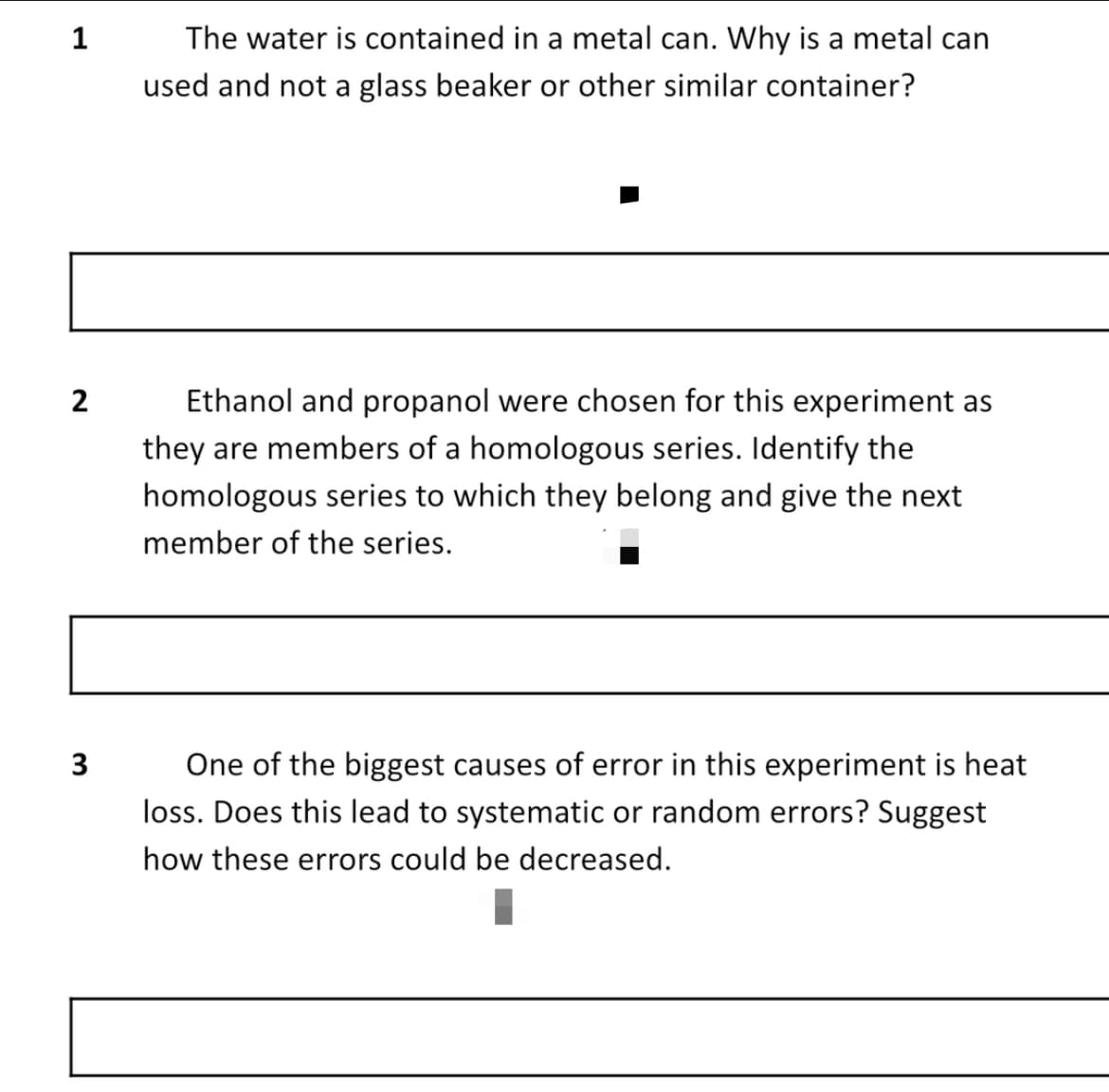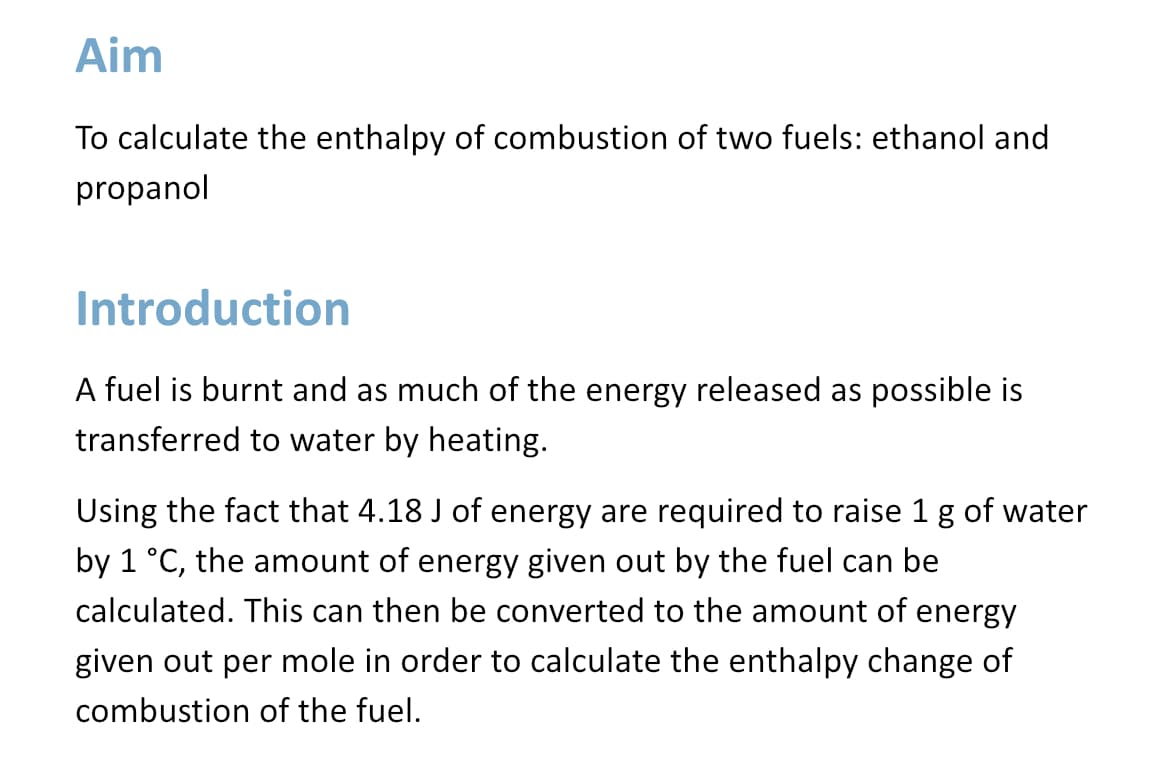The water is contained in a metal can. Why is a metal can used and not a glass beaker or other similar container? Ethanol and propanol were chosen for this experiment as they are members of a homologous series. Identify the homologous series to which they belong and give the next member of the series. One of the biggest causes of error in this experiment is heat loss. Does this lead to systematic or random errors? Suggest how these errors could be decreased.
The water is contained in a metal can. Why is a metal can used and not a glass beaker or other similar container? Ethanol and propanol were chosen for this experiment as they are members of a homologous series. Identify the homologous series to which they belong and give the next member of the series. One of the biggest causes of error in this experiment is heat loss. Does this lead to systematic or random errors? Suggest how these errors could be decreased.
Chemistry: An Atoms First Approach
2nd Edition
ISBN:9781305079243
Author:Steven S. Zumdahl, Susan A. Zumdahl
Publisher:Steven S. Zumdahl, Susan A. Zumdahl
Chapter7: Chemical Energy
Section: Chapter Questions
Problem 100AE
Related questions
Question

Transcribed Image Text:1
The water is contained in a metal can. Why is a metal can
used and not a glass beaker or other similar container?
Ethanol and propanol were chosen for this experiment as
they are members of a homologous series. Identify the
homologous series to which they belong and give the next
member of the series.
3
One of the biggest causes of error in this experiment is heat
loss. Does this lead to systematic or random errors? Suggest
how these errors could be decreased.

Transcribed Image Text:Aim
To calculate the enthalpy of combustion of two fuels: ethanol and
propanol
Introduction
A fuel is burnt and as much of the energy released as possible is
transferred to water by heating.
Using the fact that 4.18 J of energy are required to raise 1 g of water
by 1 °C, the amount of energy given out by the fuel can be
calculated. This can then be converted to the amount of energy
given out per mole in order to calculate the enthalpy change of
combustion of the fuel.
Expert Solution
This question has been solved!
Explore an expertly crafted, step-by-step solution for a thorough understanding of key concepts.
This is a popular solution!
Trending now
This is a popular solution!
Step by step
Solved in 2 steps

Knowledge Booster
Learn more about
Need a deep-dive on the concept behind this application? Look no further. Learn more about this topic, chemistry and related others by exploring similar questions and additional content below.Recommended textbooks for you

Chemistry: An Atoms First Approach
Chemistry
ISBN:
9781305079243
Author:
Steven S. Zumdahl, Susan A. Zumdahl
Publisher:
Cengage Learning

Chemistry
Chemistry
ISBN:
9781305957404
Author:
Steven S. Zumdahl, Susan A. Zumdahl, Donald J. DeCoste
Publisher:
Cengage Learning


Chemistry: An Atoms First Approach
Chemistry
ISBN:
9781305079243
Author:
Steven S. Zumdahl, Susan A. Zumdahl
Publisher:
Cengage Learning

Chemistry
Chemistry
ISBN:
9781305957404
Author:
Steven S. Zumdahl, Susan A. Zumdahl, Donald J. DeCoste
Publisher:
Cengage Learning


Chemistry by OpenStax (2015-05-04)
Chemistry
ISBN:
9781938168390
Author:
Klaus Theopold, Richard H Langley, Paul Flowers, William R. Robinson, Mark Blaser
Publisher:
OpenStax

Chemistry for Engineering Students
Chemistry
ISBN:
9781337398909
Author:
Lawrence S. Brown, Tom Holme
Publisher:
Cengage Learning

Chemistry: The Molecular Science
Chemistry
ISBN:
9781285199047
Author:
John W. Moore, Conrad L. Stanitski
Publisher:
Cengage Learning